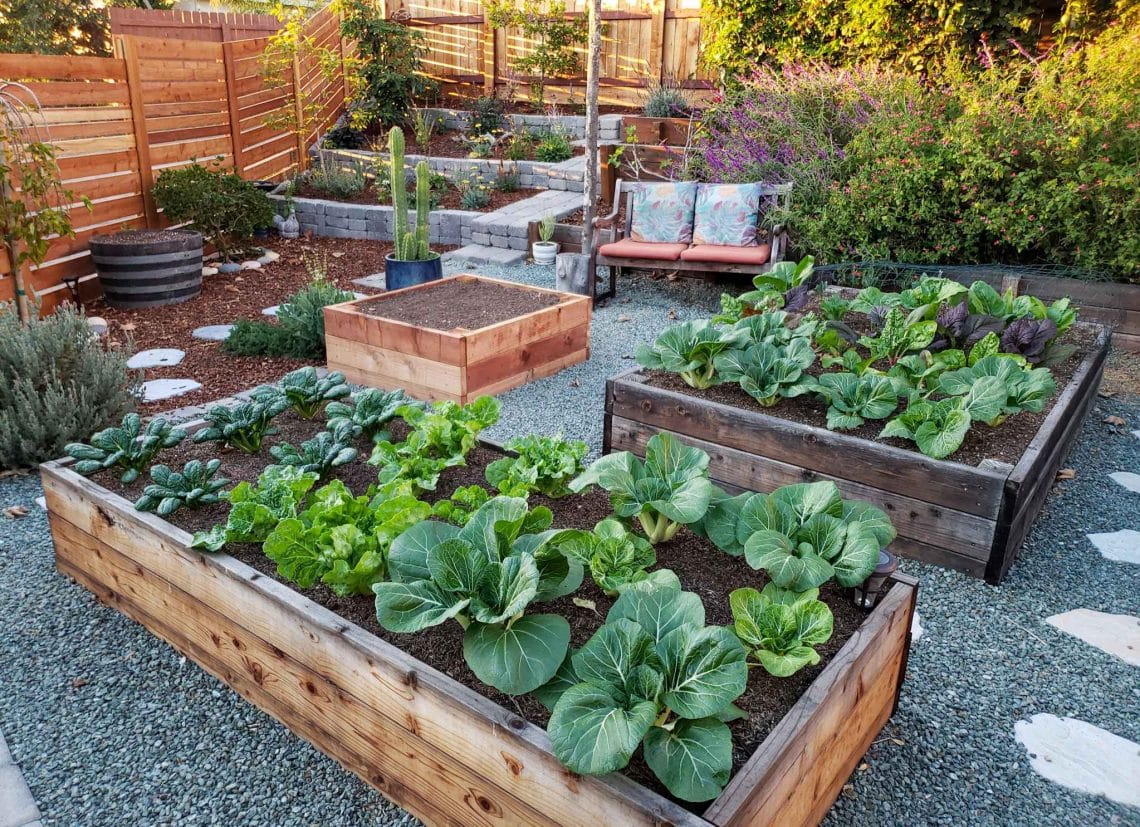
Choosing the Best Materials for Raised Garden Beds
Raised garden beds are the bees knees! We personally favor them to in-ground gardens, for a number of reasons. Raised beds can provide superior protection from pests and weeds, offer comfortable ergonomics, and can be filled with ideal soil to grow food, flowers, herbs and more. They also create a dynamic, interesting look in the landscape. When you hear “raised beds”, most folks likely conjure up images of wood planter boxes. Wood certainly is a common (and excellent!) choice for garden beds. However, you can use a variety of other materials to make raised garden beds too!
What material should I use to make raised garden beds, you wonder? Well, that depends on your personal preference, style, budget, climate, and the materials most available to you. Let’s explore the options!
This article will go over the most common (and not-so-common) materials used to make raised garden beds – including wood, metal, concrete, and more. We’ll discuss things to consider when choosing materials such as durability or safety, as well as the differences between various types of lumber. Finally, don’t miss the list of potential raised bed materials that we suggest to avoid for organic gardening.
Common Materials to Build Raised Garden Beds
- Wood lumber, including hardwood or softwood options
- Metal, such as corrugated metal or galvanized steel tubs
- Bricks, cinder blocks, or concrete blocks
- Felled logs
- Poured concrete
- Wine barrels
- Straw bales
- Large natural stones, cobblestones, or stacked rock walls
- Pallets, fence boards, or other upcycled wood
- Other miscellaneous containers or materials
Choosing the best materials for garden beds
In addition to the list above, you could create a raised garden bed out of just about anything capable of holding soil and plants! A kiddie pool, used tires, scrap wood found on the side of the road… the options seem endless. However, there are a number of factors to consider when deciding the best materials to go with. Not all are created equal!
Longevity
Select strong, durable materials to create raised garden beds if you want them to last. After all, garden beds are subject to near-constant moisture, outdoor elements, and potentially insects or pests such as termites. Plus, soil is heavy – especially once it’s wet! The more soil mass present (such as in a large or tall raised garden bed) the more pressure will be exuded on the bed walls. In that case, thin lumber can readily bow or rot. Even using the best lumber, concrete or metal beds will outlast wooden raised beds. We’ll talk more about the best wood options to build raised beds below.
Edit: Check out this newer article with 7 ways to make wood raised garden beds last as long as possible, with information on sealing, silicone and more!
Cost
Most often (but not always!), cost is directly linked to durability. High-quality materials that cost more have the potential to last decades or longer. If you opt to save money upfront and choose more affordable materials, you might be sacrificing the lifespan of your raised bed. For example, a planter box constructed of reclaimed pallets or soft pine wood likely won’t hold up half as long as one made with premium lumber. Likewise, large stones or concrete blocks will cost more than straw bales, but last a literal lifetime in comparison!
Now, that doesn’t mean you have to spend a fortune to make raised garden beds! Depending on your situation, you may be more than willing to give up a little lifespan to keep upfront costs down – especially if you’re renting your current home, or only setting up a temporary garden space. There are also plenty of ways to be resourceful and find a great deal. Hit up your local Craigslist, Facebook marketplace, junk yards, and more to forage for materials. Heck, if you have easy access to large felled logs, it’s possible to create an incredibly durable AND affordable bed.
Finally, be sure to shop around and compare prices. For example, we are able to find great deals (and a larger variety of materials) for stones, blocks, gravel, bulk soil and mulch at our locally-owned landscape supply companies. However, lumber from the local shop has proven to be cost-prohibitive, and is far more affordable at the big box hardware stores.


Safety
There are tons of creative and budget-friendly raised garden bed “hacks” out there – but I urge you to use some common sense! For instance, I would think twice before using painted or treated salvaged wood to create a garden bed for edible crops. Especially if the age and origin is unknown! The wood may be contaminated with toxic chemicals like lead, arsenic, or other heavy metals that can migrate (leach) into your soil and food. Even though modern pressure-treated wood is less toxic than stuff they used to make, I still advise against using it.
I’ve seen people use all kinds of up-cycled materials to make garden beds: like styrofoam coolers (made of polystyrene, a suspected carcinogen) or old car ties (contain benzene, polycyclic aromatic hydrocarbons, heavy metals, and a host of other substances that are toxic to human health). While I applaud the effort to reuse items in the name of sustainability, I personally don’t think it’s worth the risk. See the section below for a complete list of materials to avoid.

Types of Wood to Make Raised Garden Beds
Cedar or Redwood
Cedar and redwood are the two best choices of wood to build raised garden beds with. They’re both very durable, beautiful, and naturally resistant to moisture, rot, and even termites. The cost of each can vary significantly depending on where you live. We’ve found that redwood is more affordable on the west coast, while cedar is more readily available and thus less expensive in the eastern US.
Raised garden beds made from redwood or cedar should last a decade or longer! Water storage tanks used to be constructed of redwood, after all! Cedar and redwood are both technically “softwood” lumber, yet the high levels of natural tannins (what repels rot and termites) found in both makes them significantly more durable than other softwoods. With a higher tannin content, redwood is rumored to last a few years longer than cedar – especially if you use heart redwood.
As you’re browsing the lumber department, you should see options for “common grade” redwood or heart redwood – sometimes referred to as construction heart, ‘con heart’, or heart-B redwood. We build raised beds from heart redwood, which is more dense and therefore more long-lasting than common grade or sapwood.
As much as possible, choose lumber with an FSC certification. The Forest Stewardship Council certifies lumber that comes from “responsibly managed forests that provide environmental, social and economic benefits”.

Other wood options for raised beds
In general, hardwood lumber is more dense so it offers a superior level of durability and strength over softwood lumber. Examples of long-lasting hardwood lumber include teak, maple, beech, hemlock, walnut, black locust, and oak. Wine barrels are made of oak, both to enhance the flavor of wine but also to provide incredible moisture-resistance and longevity. We use wine barrels as raised garden beds extensively in our garden! Just be sure to drill at least half a dozen drainage holes in the bottom using a 1/2” to 3/4” drill bit.
While strong, hardwood trees grow more slowly and are therefore far less common in construction than softwoods. Popular softwood lumber includes Douglas fir, pine, spruce, and juniper. These options are typically more affordable than redwood or cedar, though not quite as durable. Raised garden beds made from these softwoods are known to last about 4 to 7 years on average (compared to 10 to 20 years for cedar or redwood), depending on your climate.
Another thing to consider is lumber size. The thickness of your wood boards directly impacts your garden bed’s lifespan too. A raised garden bed constructed of 2” thick boards will outlast a bed made of 1” boards or ½” thick fence boards – by far! We use heart redwood 2×6” boards to build our raised beds.
Learn how we build our wood raised beds with this step-by-step tutorial (video included)! Or, take a peek at some sturdy, easy-to-assemble raised bed kits here.
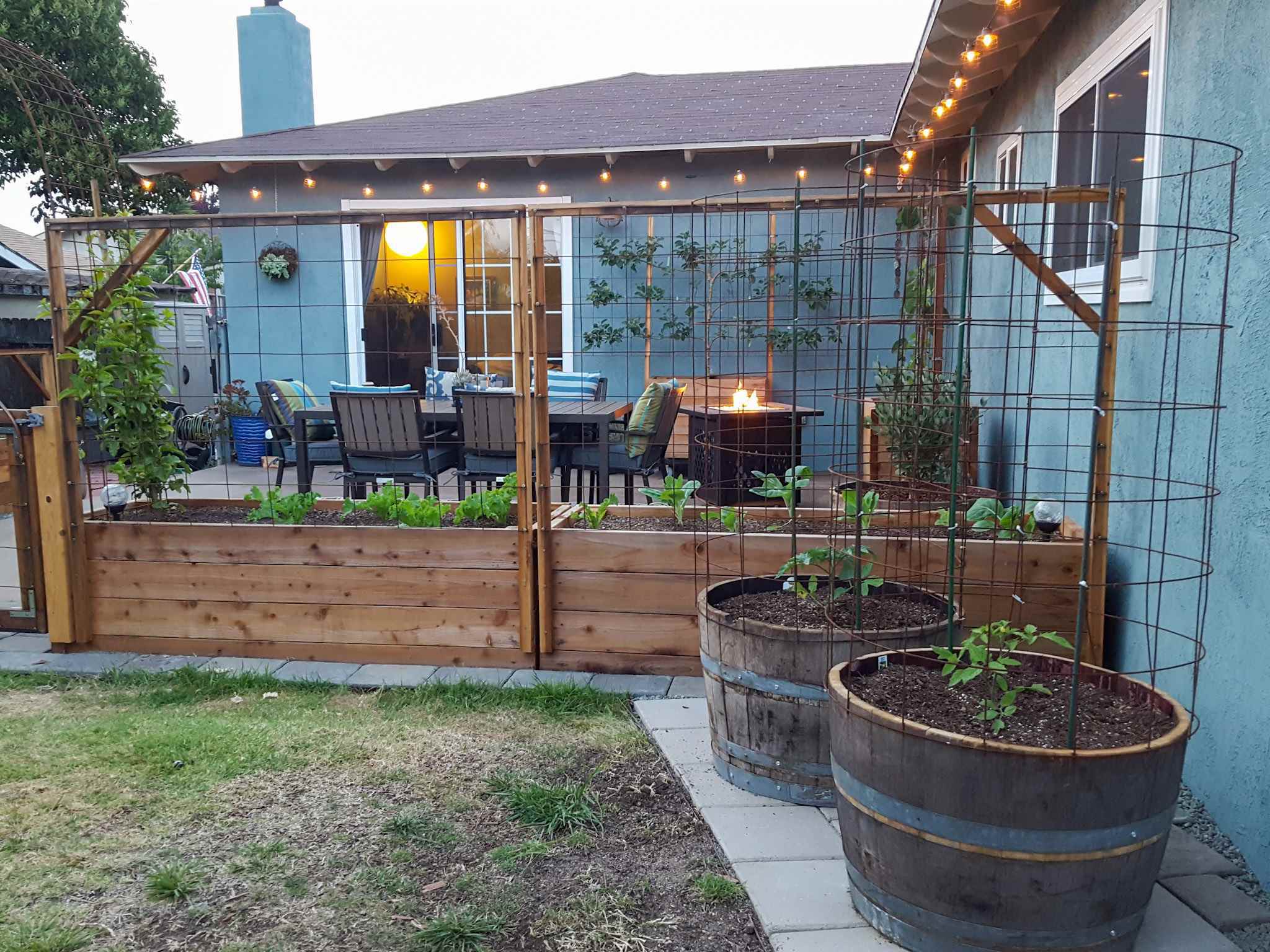
Should I seal my wood garden bed?
This is another one of those “it depends” situations! Redwood and cedar definitely don’t require a protective sealer, but may benefit from it in climates with high humidity or precipitation. If you do opt to seal your wood garden beds, choose a non-toxic sealer, such as Garden Seal or Hope’s Natural Tung Oil. Softer wood options will benefit from the added protection of a sealer even more. Follow the manufacturers recommendations for how often to apply a fresh coat.
Personally we do not seal our redwood garden beds, yet we do live in a fairly dry climate! Foggy at times… but pretty dry. We also love the way that redwood naturally ages, untouched. It starts off a beautiful pink color, turns to a slightly amber tone within a year, and then fades to a beautiful beachy-barnwood grey. Cedar also gracefully ages with time, changing from reddish tan to silver grey (unless a sealer is routinely applied).
Edit: Since moving to our new homestead and building our forever-garden, we did opt to seal the inside of the new redwood raised beds with several coats of Garden Seal to extend their life.
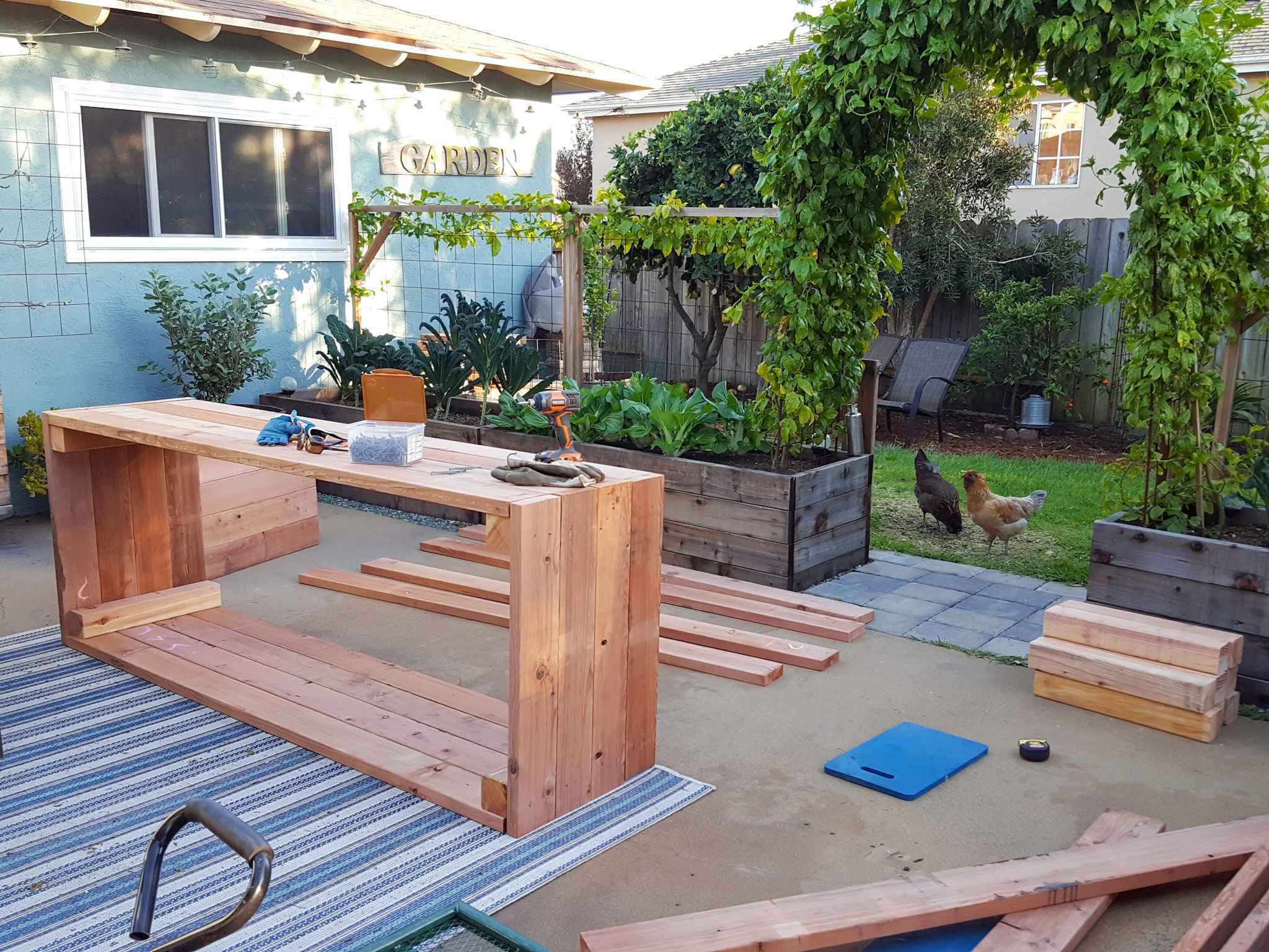
Metal Raised Garden Beds
Metal raised garden beds are becoming increasingly popular! They’re modern, sleek, and incredibly durable. Unlike wood raised beds, metal beds will not rot over time, swell and shrink with moisture, or require much upkeep. That said, galvanized steel raised garden beds are a great choice for super wet climates! Some folks may worry that metal beds will make their soil hot, but it’s nothing to be concerned about. Even if the metal feels warm to the touch, damp soil does a great job of buffering temperature swings. I know many hot-climate gardeners who use metal raised garden beds, no problem.
There are a number of metal garden bed options. You could make your own with sheets of corrugated metal as sides within a wood frame. Or, turn a prefabricated metal container into a raised garden bed – such as adding drainage holes to the bottom of a galvanized steel animal feed or water trough.
Last but not least, there are a lot of really cool metal garden bed kits out there! My friend Kevin just started selling some super durable and stylish Birdies garden bed kits, shown below. They can be made into a variety of shapes and sizes, and were previously only available in Australia. (Use code ‘deannacat3’ to save 5% off Birdies beds here!). Gardener’s Supply Company also offers a stellar selection of well-rated galvanized steel options like this modular bed kit.
No matter which direction you take, be sure to use galvanized metal so the beds won’t rust!
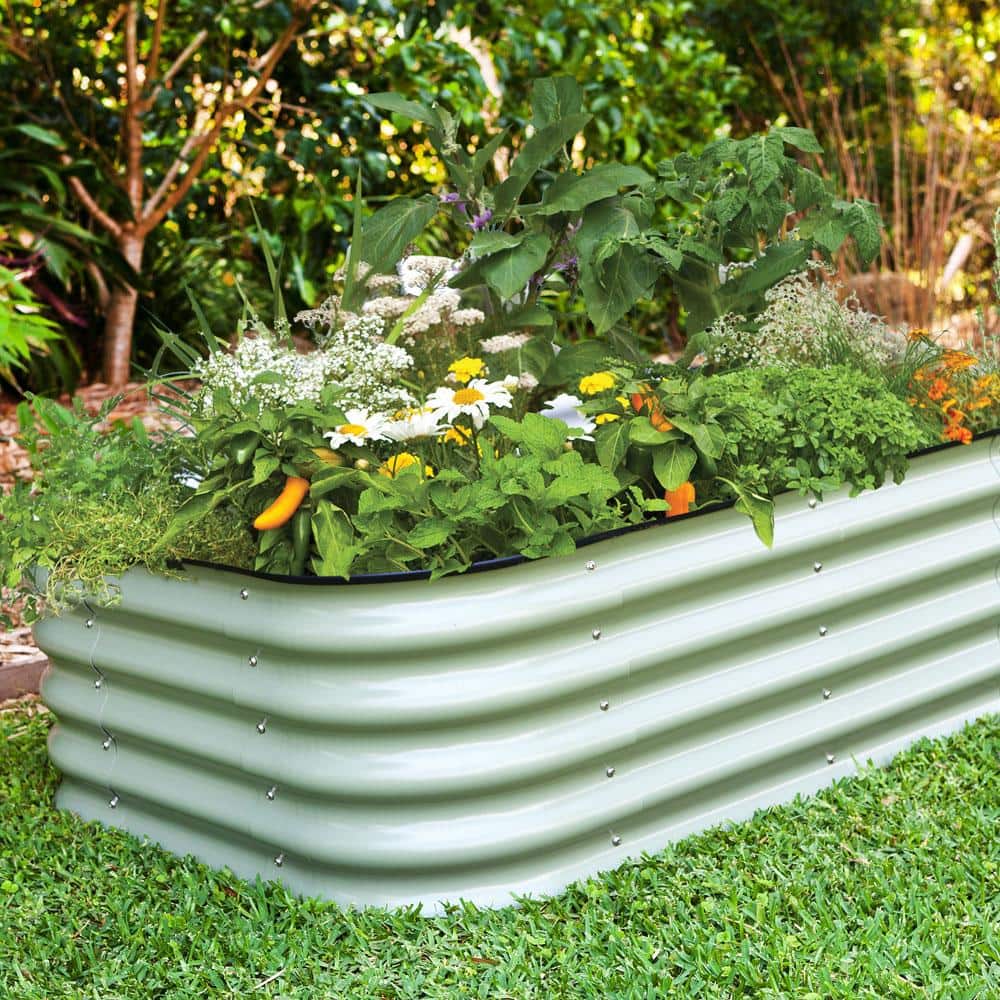
Are galvanized steel garden beds safe?
Yes, well-made galvanized steel garden beds are totally safe to grow food in! (Note the emphasis on well-made, so choose reputable and well-rated products!) Steel is an alloy of iron and carbon. Through the galvanization process, steel is coated with a layer of zinc that effectively seals it and prevents corrosion and rust. It is very unlikely for notable amounts of zinc to leach from the coating into your soil. It takes very acidic conditions and many, many years for a galvanized zinc coating to break down.
Even then, zinc isn’t a bad guy! Rather, zinc is a mineral naturally found in soil – and an essential micronutrient for plant growth! Plants rely on zinc for healthy root development, for added resilience to cold temperatures, and to support other phytochemical processes such as the formation of chlorophyll. However, if your galvanized steel beds start to visibly corrode on the interior, it is best to play it safe and replace them.
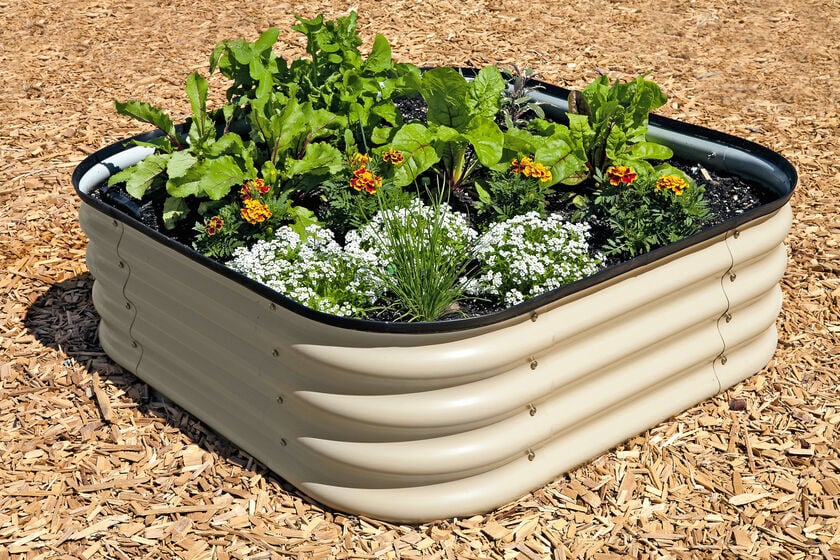
Making Raised Garden Beds from Concrete, Brick or Cinder Blocks
Like those made from metal, raised garden beds constructed from concrete pavers, cinderblocks, or brick have the potential to be supremely durable and sturdy. However, this category comes with a few caveats to consider! The installation of concrete block garden beds require a decent level of commitment, especially if you secure them in place with mortar or adhesive. They’re heavy, create a more permanent design than other options, and thus limit your flexibility for change.
It’s possible to make garden beds from pavers or blocks without adhesive (e.g. simply by stacking blocks) if you keep them fairly shallow. Yet you’ll want to secure them in place if you’re creating a bed two feet or taller, in an area prone to heavy rains or flooding, on a slope, or to otherwise create a more sturdy installation. It’s also possible to find interlocking blocks made for mortarless wall systems.
We have made a number of raised garden areas with concrete blocks and secured them with construction concrete adhesive (the same way we made our concrete block greenhouse foundation). The adhesive is probably not entirely non-toxic, but we only used a small bead of glue deep between each block. Also, those beds primarily house ornamental plants over edibles. Be sure to let your adhesive fully dry and cure before adding soil!
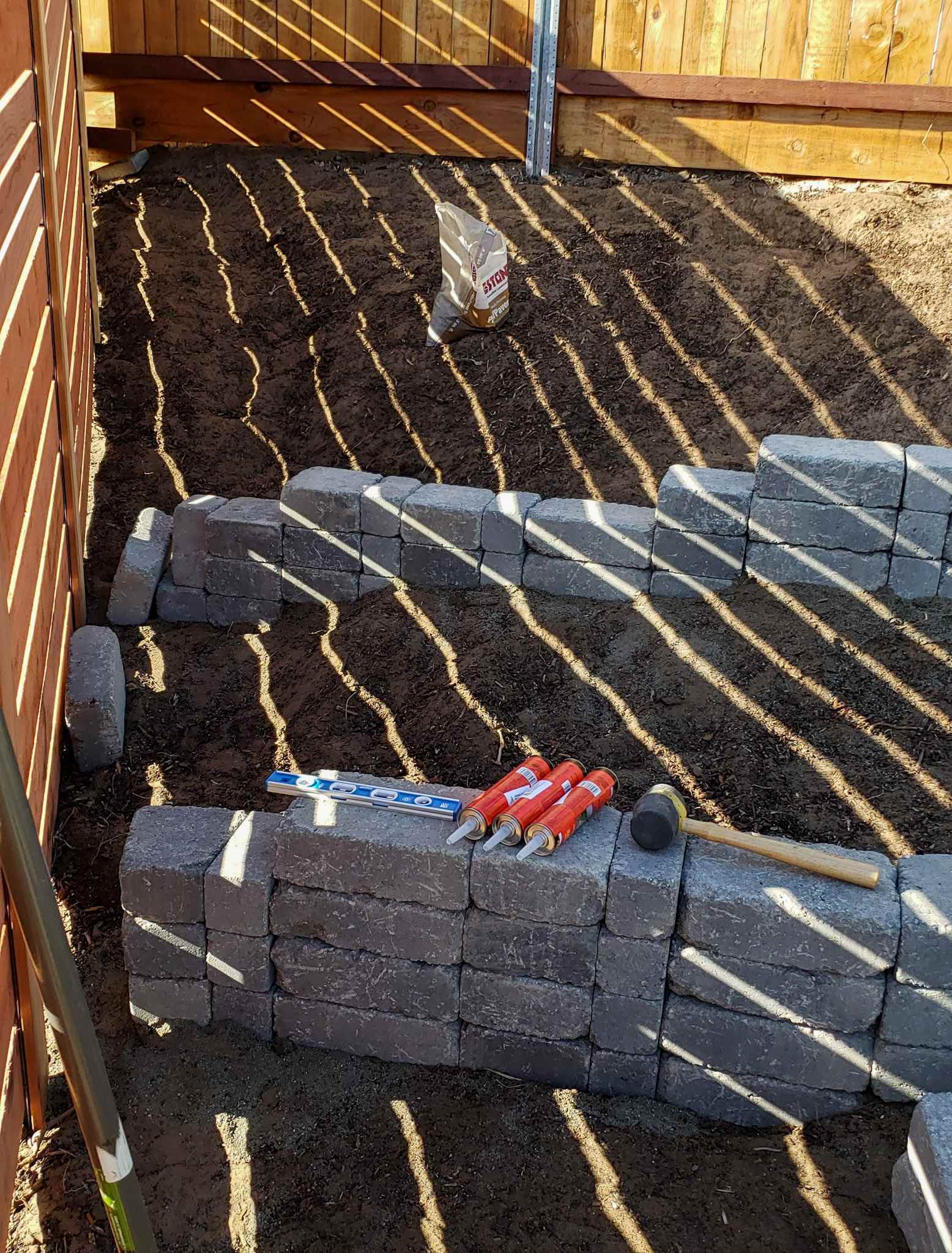
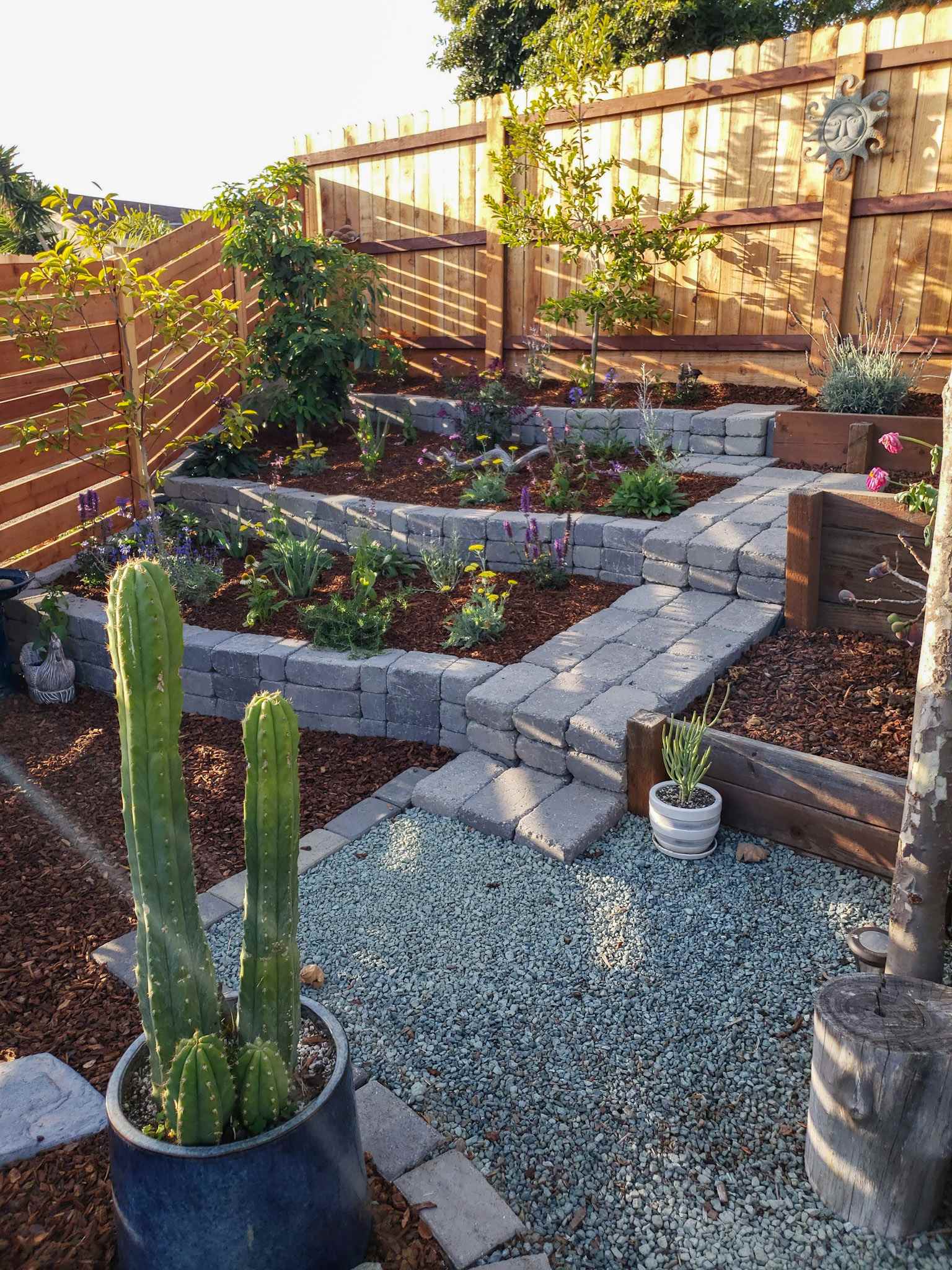
Are concrete blocks or cinder blocks safe for gardening?
Fly ash is a common concern when using pavers, bricks, or cinder block materials to create raised garden beds. Fly ash is a masonry additive that contains heavy metals such as radium and arsenic, and is often used in concrete products for added durability. However, there is very little scientific evidence available that says whether or not those heavy metals readily leach into the surrounding soil. If you’re concerned about this risk, buy your materials from a reputable source where you can ask questions and check specifications to see if fly ash is present or not.
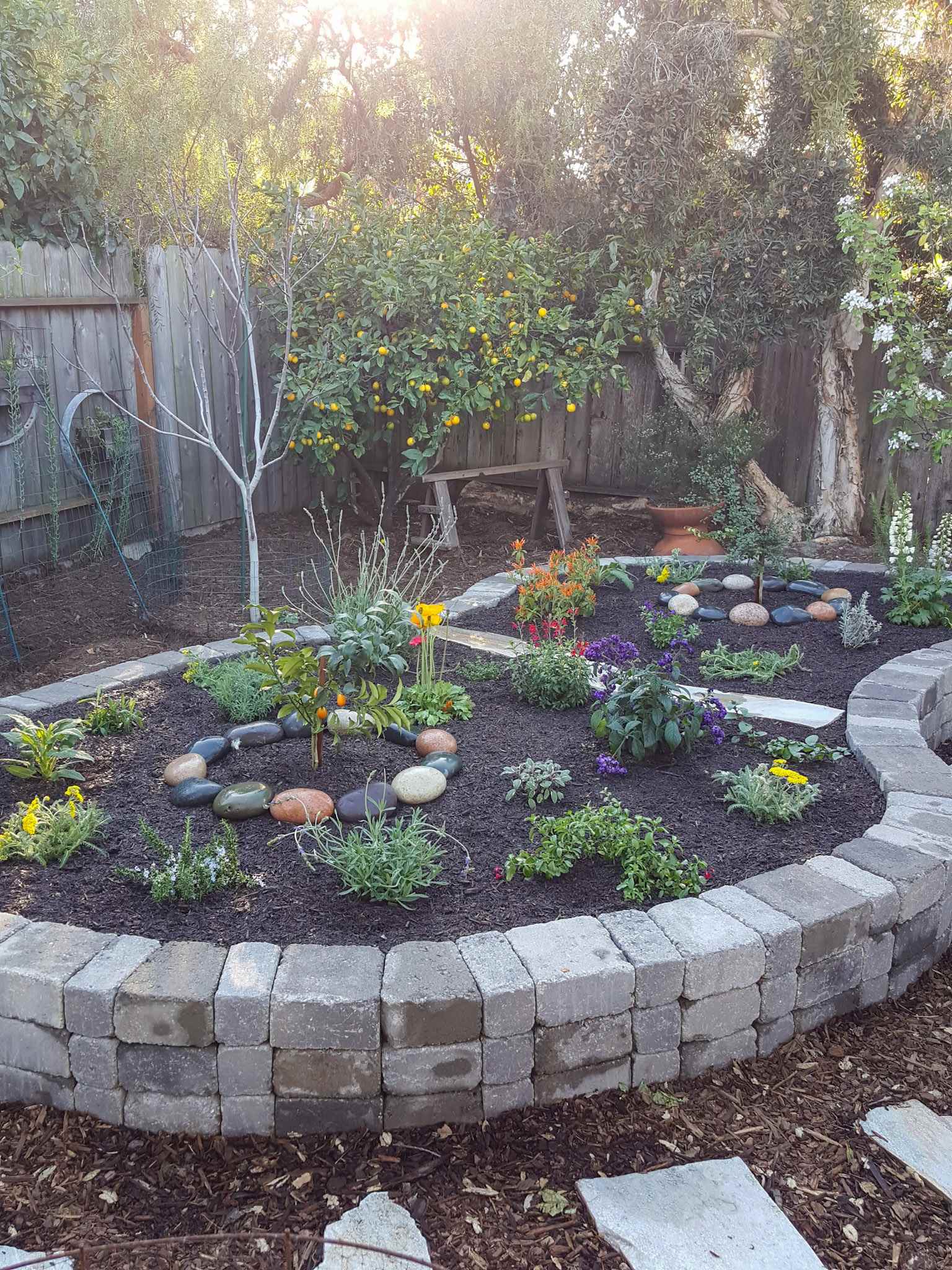
Natural Stone Raised Beds
Going beyond concrete blocks, you can make long-lasting raised planting areas using natural stone too – such as cobblestones, flagstone, small boulders, or other foraged rock material. Unlike concrete, there is no worry about chemical additives here. Natural stones and rocks can be freely stacked, or mortared/glued in place. Because the shapes and sizes of natural rocks aren’t as cookie-cutter as concrete blocks, the construction will require more imagination and finagling to puzzle-piece them together. Yet the finished result will be even more rustic, artistic, and beautiful – and blend in beautifully in a natural garden setting!
Avoid using these materials for raised garden beds:
- Railroad ties. While they seem kinda funky-cool, railroad ties are treated with creosote – a ‘probable’ human carcinogen. Creosote may also inhibit or harm plants growing nearby.
- Recycled or reclaimed wood of unknown origin. As we explored earlier, if you are unsure of the origin, age, or treatment of the wood, be leery. It could have been treated, stained, or painted in a way that would introduce toxins into your garden.
- Treated lumber, or pressure treated lumber. This one is up for debate with some gardeners. Historically, pressure treated lumber was cured with an arsenic-based compound called chromated copper arsenate (CCA). Arsenic is very bad news, and studies show that it readily leach from the treated lumber into the surrounding soil. The purpose was to make fairly cheap wood (namely pine) last longer against the elements. Though CCA was banned in 2003 and replaced with various less-toxic copper-based chemicals, I still personally avoid treated lumber. After all, the expected lifespan of redwood and cedar actually outlasts modern pressure-treated pine by several years! So, why choose the chemically-treated materials for your raised garden beds?
- Other risky materials such as styrofoam, used car tires, or miscellaneous plastic products (as discussed in the safety section above). If you’re considering a plastic garden bed kit, be sure it is made with food-grade BPA-free plastic.
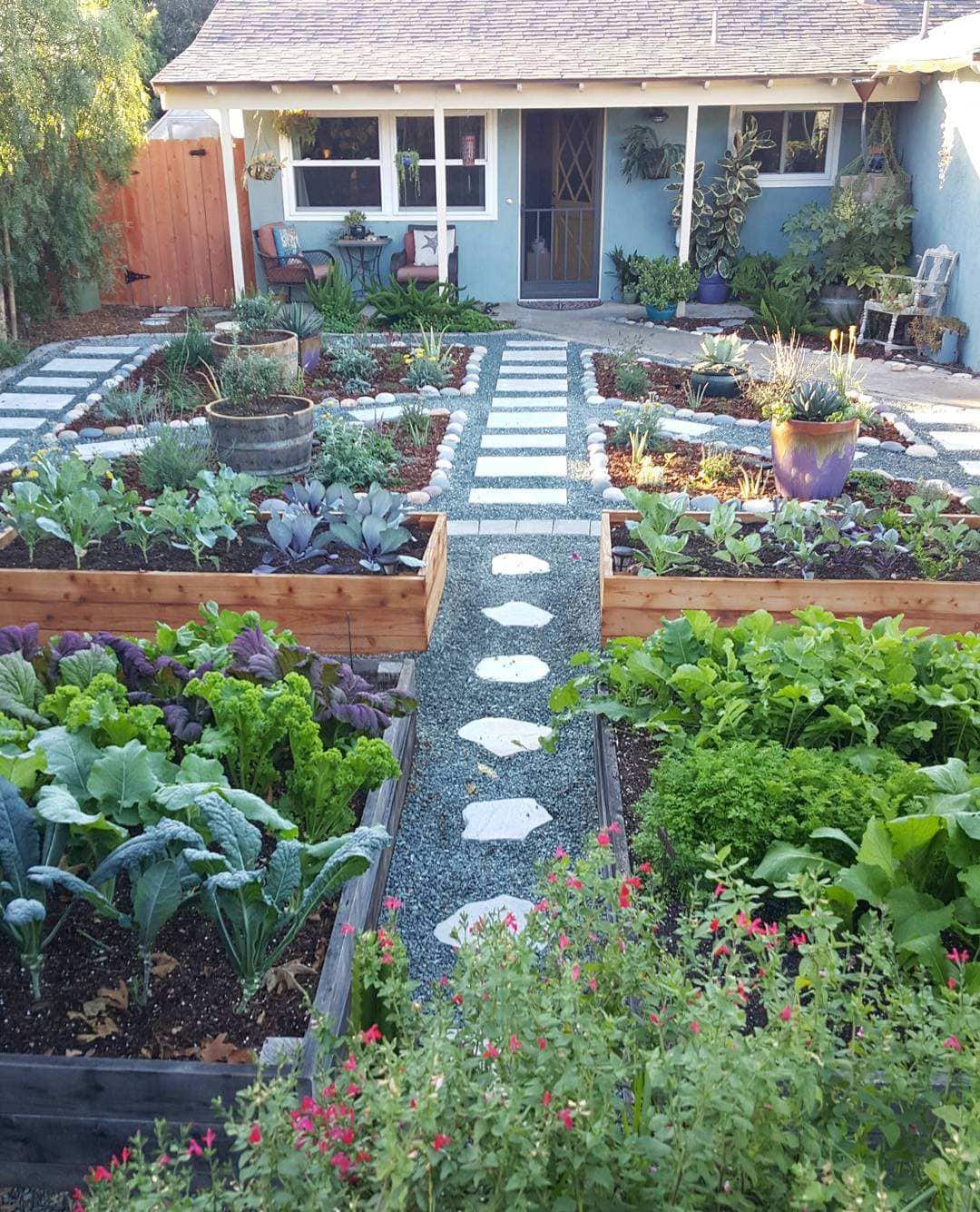
Decisions, decisions…
Well folks, that concludes this discussion on the most popular materials used to make raised garden beds! I hope that the information provided here will help you make an informed decision on what will work best for your garden. Perhaps you will mix-and-match styles? No matter what, I’m sure it will come together beautifully!
Once you have your beds installed, check out this article all about how to fill raised garden beds with the “perfect” (I hate that word, lol) organic garden soil mixture. Please feel free to ask any questions in the comments below, and share this article if you found it valuable!
You may also enjoy these related posts:
- How to Design & Build a Raised Garden Bed
- How to Fill a Raised Garden Bed: Build the Perfect Organic Soil
- Pros and Cons of Raised Beds vs In-Ground Gardens
- How to Build a Trellis: 2 Easy & Inexpensive DIY Designs
- The Benefits of No-Till (No-Dig) Gardening or Farming
- How to Install a Raised Garden Bed on Concrete, Patio, or Hard Surface
- How to Amend & Fertilize a Garden Bed Before Planting (or Between Seasons)



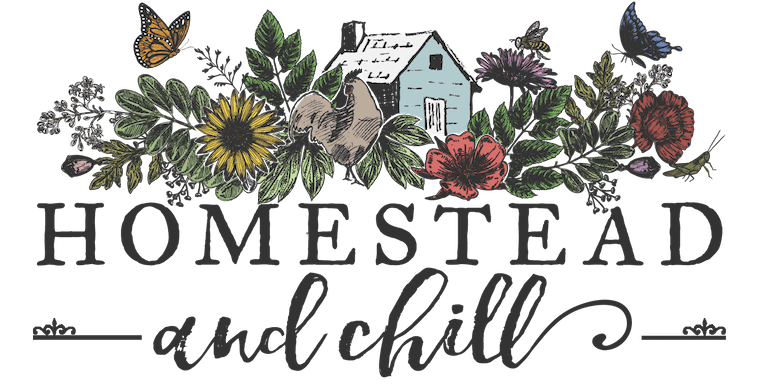
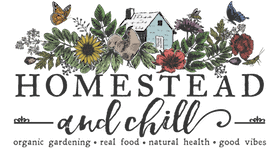
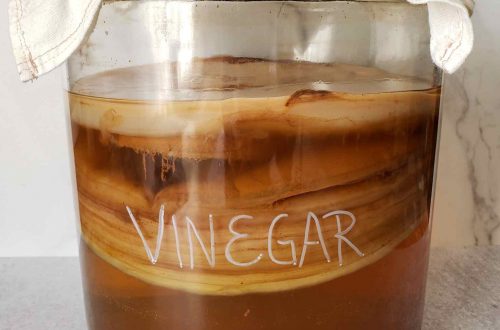
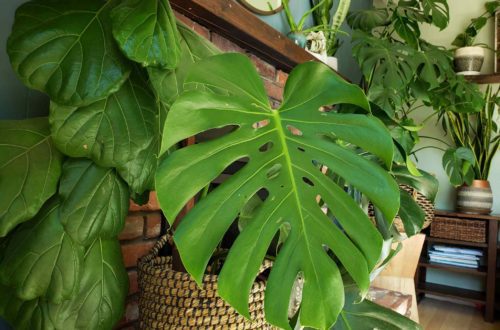
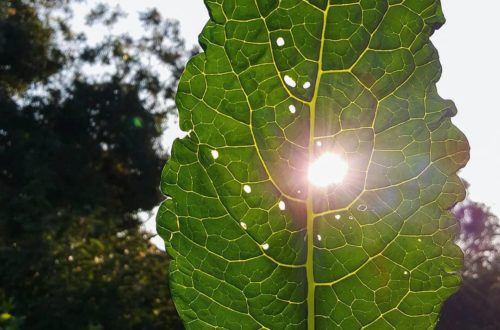
23 Comments
Pam
Hi Great info, what about using old barn boards? We have an old barn that is falling apart and I would like to repurpose the barn boards to make the garden raised beds. Are they a safe material? They are not painted, but very old.
Aaron (Mr. DeannaCat)
Hi Pam, I am sure the old barn boards are likely safe to use to make garden beds, if the boards are thinner like boards for fencing or siding, the raised beds may not hold up as long as thicker 2 inch boards. Either way, it sounds like you have some nice material to play around with and to make some nice raised beds or planters. Hope that helps and good luck!
EILEEN Stimeling
Do you think I can use standing seam roofing for raised beds? It red on one side and tan on the other.
Aaron (Mr. DeannaCat)
Hello Eileen, while I am not entirely familiar with the materials used in the seam roofing, corrugated metal or galvanized steel would be ideal. And if so, I think it would be a great material to use for the siding of your raised beds. Good luck!
Mr. Drew
I am thinking of using this design except making the 4×4 posts longer so I can put it on my deck. My question is: what should I put on the bottom to hold in all the soil? I feel as though plywood would be a bad idea. Perhaps, I could use the same cedar planks just sliced up smaller and side by side? Also, will I want this to drain?
Aaron (Mr. DeannaCat)
Hello Mr. Drew, we have found that raised planters don’t quite do as well as raised beds placed on the ground itself. We have an article on How to Build a Raised Garden Bed on Concrete, Patio, or Hard Surface but it doesn’t include legs and it will likely get your deck dirty due to water runoff. If you want to keep a clean deck you will likely want to find a tray/saucer that can fit underneath the planter box as you will have runoff due to watering or when it rains. Check out these raised bed kits from Gardener’s if you want a few more ideas or possibly want one ready made. Hope that helps and good luck!
Rosie
Concerning raised beds. What about decking material like Trex. We want to redo our deck and use the old trex for raised beds. Would this be a good idea? Thanks!
Aaron (Mr. DeannaCat)
Hi Rosie, using your Trex boards for raised garden beds sounds like a great way to reuse old materials to give them a second life. Good luck on building your raised beds and redoing your deck!
pj
Is a powder coated steel raised bed safe for growing vegetables – I was wondering because I don’t know much about the powder coat material. I see a lot of these raised beds and don’t want to grow veggies in one if the powder coat is not safe.
Aaron (Mr. DeannaCat)
Hi PJ, the Birdies raised beds linked in the article are made out Aluzinc steel which is considered even stronger and more durable than galvanized steel. The metal is often used in rainwater harvesting tanks and I would not be worried about any chemicals leaching into the soil. Though there are lesser quality metal beds out there that you may have to be more discerning of. Hope that helps and good luck!
Amanda
Thank you so much for this information, so valuable! I’m curious your thoughts on lining a standing bed with anything to keep the soil and moisture in? We have a bed on legs on our deck and I used tung oil to seal the redwood before the soil went in but there is a lot of drainage that runs through so I’m pausing before I add more soil. I’ve always avoided plastic because it seems unwise to add possible BPA to our food. Would love to hear any advice on this. Do we give it a liner or just keep up with the quality of the soil?
Aaron (Mr. DeannaCat)
Hi Amanda, that is one of the difficulties of having a raised bed on legs or on concrete as you will see the runoff. I wouldn’t add a plastic liner to the inside of the bed as your soil may get overly wet and soggy, causing anaerobic conditions which are to be avoided. You may be able to line the inside of the bed with a fabric material that they use to make fabric grow bags which may help somewhat with water absorption but it will still allow water to pass through it. You can also add a drip tray to the bottom of the bed to catch runoff although it won’t be too pretty to look at. For beds that are on concrete or raised beds that have legs, the soil moisture must be monitored to assure that you don’t overwater the bed which results in a lot of runoff. However, if you are having trouble with keeping the soil moist and still have runoff issues, a drip tray underneath may be the best option. Hope that helps and good luck!
Amanda Jones
This is immensely helpful, thank you so much!
Alyx
Thanks so much for the well informed article. I’m going to go with a cedar bed and I’ll seal it with your recommended Garden Seal. In the winter (snow and ice) would it help increase the longevity of the planter if I protect it with a tarp or something of the like? Thank you!
Aaron (Mr. DeannaCat)
Hi Alyx, while we don’t have to deal with snow or harsh winters here, it seems that preparing your raised bed for winter mostly involves weeding or harvesting remaining plants, adding a layer of compost and mulch, while also planting some type of cover crop such as oat, buckwheat, or red clover which will help keep weeds out while enriching your soil. You can probably cover your raised bed with a tarp or plastic before the snow sets in but the snow itself may insulate or protect your bed once it is covered in it anyway. Hope that helps and good luck!
David D
Thanks for the article. We are nearing retirement years so long-term maintenance is becoming a bigger factor in our decisions. Rebuilding raised beds in 6-10 years may not be in our plans, but the initial cost of stone beds is way up there. Based on your article, for durability I am considering galvanized steel beds clad with wood or felled tree logs for aesthetics.
Moles, voles, and gophers are a big problem for us and laying 1/4″ stainless steel hardware cloth underneath will help considerably from under ground, but I’m wondering how to keep the voles from scaling the raised bed sides and eating many of our vegetables?
Aaron (Mr. DeannaCat)
Hello David, Unfortunately (or fortunately) we don’t have many vols to deal with so we aren’t as familiar with them as the other subterranean rodents. If you go with a galvanized steel raised bed option that is at least two feet, maybe that will be enough of a hike for most vols not to venture that far? However, aside from the usual tricks to keep vols out of your garden you could use additional hardware cloth to erect a “fence” that is 6-12 inches in height around the outer perimeter of your soil line to provide additional protection. It may be a good idea to start off with a smaller bed or larger fabric grow bag to see how the vols respond to your vegetables which will give you insight on how far you have to go to defend your garden. Hope that helps and good luck on your next chapter in life!
Joe W
Hi from Colorado– I really liked your article, it was well thought-out and normally I can be quite a critic of these types of articles because people put out bad information. But this one– I’m bookmarking it! Good job.
Aaron (Mr. DeannaCat)
Thanks Joe, Best of luck to you!
Bedour
Hello.
Do i have to ise cardboard or something else as a base for the plant bed ?
Tnanks alot
Aaron (Mr. DeannaCat)
Hi Bedour, you can use cardboard on the bottom if you don’t have invasive weeds or gophers to deal with. We have a more in depth article on How to Build a Raised Garden Bed: Step-by-Step Guide for more information. Hope that helps and good luck!
Bessi
Hello. I am getting some planter boxes made for the purpose of growing organic herbs and veggies.
If I have a choice of Hemlock or Cedar, what would be better in terms of food safety and longevity of the planter? thanks if you can advise.
Aaron (Mr. DeannaCat)
Hello Bessi, hemlock and cedar will both hold up quite well with possibly cedar lasting a few more years. If they are roughly the same price point I would opt for the cedar planter box but if you can save some money on the hemlock planter box, it would be a fine option as well. Hope that helps and good luck!